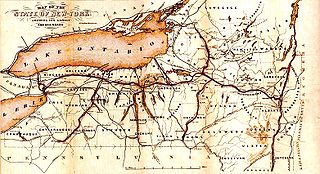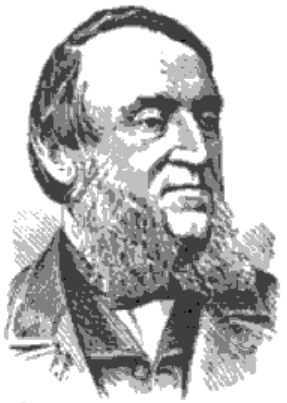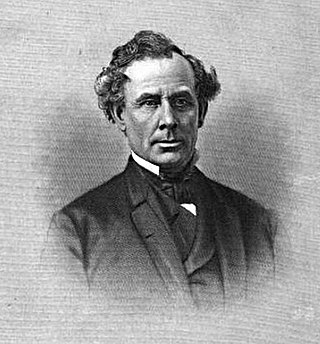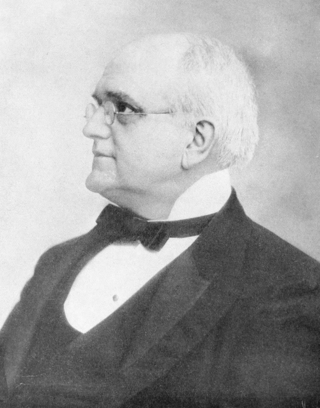Robert C. Dorn | |
|---|---|
| Erie Canal Commissioner | |
| In office 1866–1868 | |
| Personal details | |
| Nationality | American |
| Political party | Republican |
| Residence | Schenectady, New York |
| Profession | Politician |
Robert C. Dorn was an American politician from New York. In 1865, he was elected Canal Commissioner on the Republican ticket. [1] In May 1868, he was put on trial by the Senate of New York in the Court of Impeachment, [2] becoming the second person tried by the New York Court for the Trial of Impeachments.
Robert C. Dorn lived in Schenectady, New York. [3]
He was appointed Superintendent of Canal Repairs for Section 2 of the Erie Canal, when he was named the Superintendent of Repairs for only section # 2 in January 1856, with William Eggleston becoming superintendent for #1. [4] He was then appointed Superintendent of Canal Repairs for Sections 1, 3, 4 and 5 until the end of 1864, and continued with Sections 1, 2 and 3 in 1865.
As of 1865, all repair sections of the canal were in charge of Robert C. Dorn as superintendent, and he was replaced in that role on January 24, 1855, when George Heath was appointed superintendent for sections four and five, with Dorn remaining in charge of one, two, and three. [5]
He was selected to run for Canal Commissioner on the Republican ticket on September 20, 1865, [3] after being nominated at the New-York Republican Union State Convention. [3] [6] In November 1865, Dorn won the race [1] in the New York state elections of 1865. He took the role of Canal Commissioner on January 1, 1866, [7] with the term to last three years. [8] He was a Canal Commissioner from 1866 to 1868.
It was published in 1870 that $16,340 had been transferred from the Fund of the Erie Canal Enlargement for enlargement and completion of the canals to the Canal Commissioners, with Robert C. Dorn of the Eastern Division receiving $376 of that total. Tolls on the Erie canal were reported to be $3,666,093, with Dorn as of September 30, 1868, holding $5,450 of the balances on hand for the Canal Commissioner. He oversaw a number of financially significant improvement investments on the canal, including $27,166 for "extraordinary repairs". [9]
Many New Yorker's felt corruption was a major cause of the canal system's troubles. In 1867 at the state Constitutional Convention, Erastus Brooks alleged canal contracts of being awarded to the highest bidder. [10] A commission was established, consisting of James Gibson, Henry C. Murphy, Charles Stanford, William Bristol, William S. Clark, George W. Millspaugh, and counsel Henry Smith. [11] It concluded there were "gross and monstrous frauds". [10]
Concerning Dorn's history of awarding contracts, a court assembled in the Albany Senate Chamber on March 31, 1868, under Stewart L. Woodford, Lieutenant-Governor of the State and President of the Senate. [7] The managers appointed to conduct the trial were John C. Jacobs, John L. Flagg, John F. Little, William B. Quinn, E. L. Pitts, Alpheus Prince, and N. B. La Ban. The honorable William A. Beach, John H. Reynolds, and Henry Smith were counsel for the Dorn. [2] Assembled to ascertain whether Dorn had, in 1886 and 1867, awarded construction contracts in a corrupt fashion while ignoring a prior law to select the cheapest bid, [7] a resolution impeaching him of high crimes and misdemeanors passed the assembly with a unanimous vote. [2]
The court re-assembled in the Senate Chamber on April 2, 1868. [7]
He was impeached by an unanimous vote of the New York State Assembly. The First Article charged him with "complicity in a combination made by contractors." Article Two charged him with "letting a contract to the highest instead of the lowest bidder." Article Four charged him with "letting contracts without advertising some." [7]
In May 1868, the Court of Appeals and the New York Senate met jointly as a Court of Impeachment to settle the matter of Dorn's case. [12] The trial before the Court of Impeachments opened on May 26 at Albany. [13] During the first meeting, there was a motion from the defense to quash the Fourth Article accusations of Dorn awarding contracts without advertising them first. [14] On May 27, 1868, the Court of Appeals and the Senate again met jointly as a Court of Impeachment, with counsel for the defendant arguing that senator Sandford, as Chairman of the Canal Investigating Committee, had prejudged the case on several points. [12] On June 12, 1886, Dorn was acquitted with a vote of 8 for conviction, among them Martin Grover, Theodore Miller, and 19 against, [15] among them Ward Hunt, Lewis B. Woodruff, Charles Mason and William J. Bacon. [7] He was acquitted of all charges. [16]

Harrison Jackson Reed was an American editor and politician who had most of his political career in Florida. He was elected in 1868 as the ninth Governor of Florida, serving until 1873 during the Reconstruction era. Born in Littleton, Massachusetts, he moved as a youth with his family to Milwaukee, Wisconsin, where he had a grocery store and started farming. He also owned and edited the Milwaukee Sentinel for several years.

The Canal Ring was a group of corrupt contractors and their political supporters in the 1860s and 1870s who defrauded the State of New York by overcharging for repairs and improvement of the state's canal system. It consisted largely of a group of loosely organized Democratic and Republican Assemblymen and State Senators, led by Jarvis Lord in the Assembly and William Johnson in the Senate. The firm Belden & Denison made the most money from the scam, though numerous contractors were involved.

William Jarvis McAlpine was an American civil engineer and politician from New York. He was New York State Engineer and Surveyor from 1852 to 1853.
The Erie War was a 19th-century conflict between American financiers for control of the Erie Railway Company, which owned and operated the Erie Railroad. Built with public funds raised by taxation and on land donated by public officials and private developers, by the middle of the 1850s the railroad was mismanaged and heavily in debt. A cattle drover turned Wall Street banker and broker, Daniel Drew, at first loaned $2 million to the railroad, and then acquired control over it. He amassed a fortune by skillfully manipulating the Erie railroad shares on the New York Stock Exchange. Cornelius Vanderbilt, who set his mind on building a railroad empire, saw multiple business and financial opportunities in railways and decided in 1866 to corner the market on Erie by silently scooping-up the Erie railroad stock. After succeeding, Vanderbilt permitted Drew to stay on the board of directors in his former capacity as treasurer.
The Court for the Trial of Impeachments, and the Correction of Errors was established by the New York State Constitution of 1777. It consisted then of the Lieutenant Governor of New York, the Chancellor, the justices of the New York Court of Appeals and the members of the New York State Senate. It had two distinct jurisdictions: the trial of State officers who had been impeached by the New York State Assembly, and it served as a court of last resort in which decisions of either the New York Supreme Court or the Chancellor could be reversed.
William I. Skinner was an American politician from New York.
Alexander Barkley was an American politician from New York.

The 1865 New York state election was held on November 7, 1865, to elect the Secretary of State, the State Comptroller, the Attorney General, the State Treasurer, the State Engineer, two Judges of the New York Court of Appeals, a Canal Commissioners, an Inspector of State Prisons and the Clerk of the Court of Appeals, as well as all members of the New York State Assembly and the New York State Senate.
Samuel Works was an American politician from New York.

The 76th New York State Legislature, consisting of the New York State Senate and the New York State Assembly, met in Albany from January 4 to July 21, 1853, during the first year of Horatio Seymour's governorship.

The 89th New York State Legislature, consisting of the New York State Senate and the New York State Assembly, met from January 2 to April 20, 1866, during the second year of Reuben E. Fenton's governorship, in Albany.

The 91st New York State Legislature, consisting of the New York State Senate and the New York State Assembly, met from January 7 to May 6, 1868, during the fourth year of Reuben E. Fenton's governorship, in Albany.
Jacob Worth was an American politician from New York.

The Cleveland, Painesville and Ashtabula Railroad (CP&A), also known informally as the Cleveland and Erie Railroad, the Cleveland and Buffalo Railroad, and the Lake Shore Railroad, was a railway which ran from Cleveland, Ohio, to the Ohio-Pennsylvania border. Founded in 1848, the line opened in 1852. The railroad completed the rail link between Buffalo, New York, and Chicago, Illinois.
Cornelius W. Armstrong was an American merchant and politician from New York.

Stillman Witt was an American railroad and steel industry executive best known for building the Cleveland, Columbus and Cincinnati Railroad, Cleveland, Painesville and Ashtabula Railroad, and the Bellefontaine and Indiana Railroad. Through his banking activities, he played a significant role in the early years of the Standard Oil company. He was also one of the founding investors in the Cleveland Rolling Mill, a major steel firm in the United States.

During his presidency, Andrew Johnson, the 17th president of the United States, saw multiple efforts during his presidency to impeach him, culminating in his formal impeachment on February 24, 1868, which was followed by a Senate impeachment trial in which he was acquitted.
Benjamin Nicoll Huntington was an American farmer, banker, and politician from New York.

George Milton Curtis was an American lawyer, politician, and judge from New York.

Andrew Johnson became the first president of the United States to be impeached by the United States House of Representatives on February 24, 1868 after he acted to dismiss Edwin Stanton as secretary of war in disregard for the Tenure of Office Act.